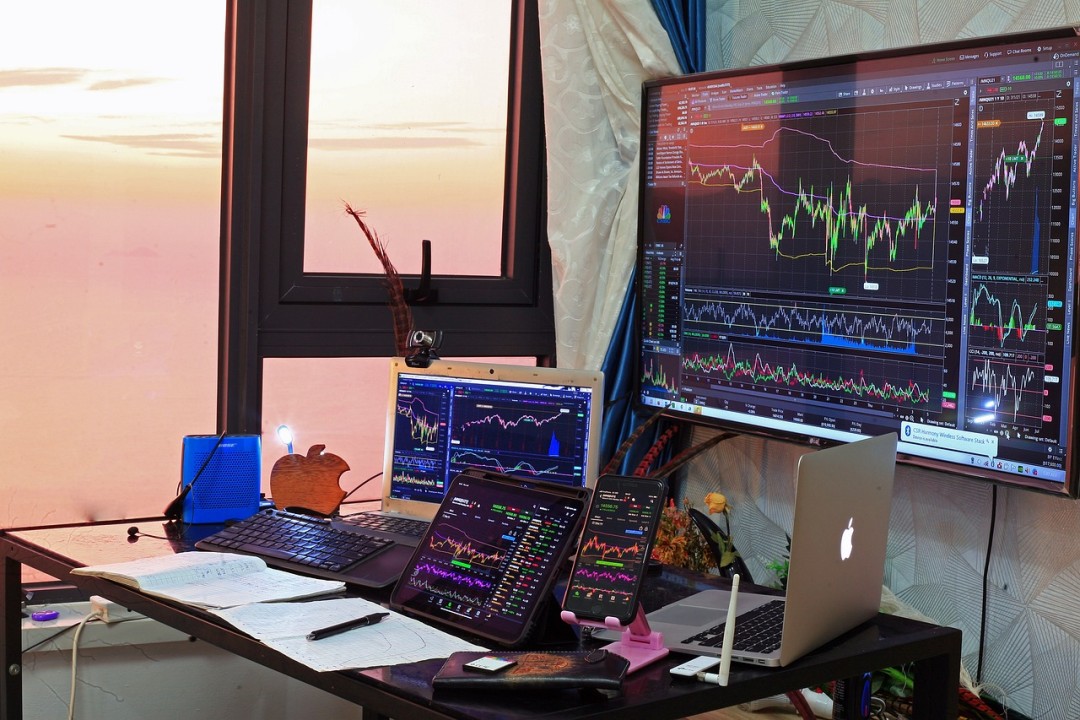Day Trading vs Long-Term Investing: What's the Difference
Discover the key differences in day trading vs long-term investing to see which strategy fits your goals, risk tolerance, and timeline.

Choosing how to invest your money can feel like navigating a maze. Should you jump into day trading or play the long game with traditional investing? Each choice has its benefits and risks, and your decision comes down to your goals.
Want quick wins? Day trading could be your ticket. However, if you’re considering future security, long-term investing may be the best approach. And if you need help deciding, knowing the best brokers for day trading can guide you as you get started.
AquaFunded's funded trading program is an excellent resource if you’re ready to start trading. They can help you maximize profit with a funded trading account by giving you the capital, resources, and support you need to succeed.
Pros and Cons of Day Trading

Pros of Day Trading: The Highs of the Hustle
1. Potential for High Returns
Day trading can be exceptionally lucrative when done right. The ability to leverage trades means even small market movements can lead to substantial gains. Traders with sharp instincts and swift execution skills can rake in impressive profits.
2. Independence and Freedom
Day trading offers the allure of being your own boss. With just an internet connection, you can trade from anywhere and set your own schedule. This independence is a magnet for those tired of the nine-to-five grind.
3. Quick Decision-Making
In day trading, decisions must be made on the fly. This fast-paced environment tests your analytical mettle and can be intellectually stimulating for those who thrive under pressure.
4. Limited Overnight Risks
By closing trades at the end of the day, you sidestep the dangers of overnight market shifts. This control helps you manage your risk more effectively.
5. Liquidity and Access
Day trading thrives in liquid markets, where entering and exiting trades is a breeze. Thanks to technology, day trading is more accessible than ever, letting anyone get in on the action.
6. Immediate Feedback
The beauty of day trading is the instant feedback you get on your strategies and decisions. This real-time evaluation helps you learn quickly and refine your approach.
Cons of Day Trading: The Downside to the Rush
1. High Risk and Big Losses
With the potential for high returns comes the reality of high risk. Day trading can be a financial minefield, and even seasoned traders can face significant losses if they’re not careful.
2. Time-Consuming Commitment
Make no mistake: day trading is a full-time gig. It demands long hours of market analysis and trade monitoring. If you’re not ready to put in the time, success will be elusive.
3. Emotional Rollercoaster
Day trading isn’t just financially taxing—it’s emotionally draining too. The constant pressure, fear of losses, and thrill of gains can take a toll on your mental health.
4. Costly Fees
Frequent trades rack up transaction costs and fees, which can eat into your profits. It's crucial to consider these costs when planning your strategy.
5. Risk of Addiction
The adrenaline rush of day trading can become addictive, leading to reckless decisions. It’s essential to keep your trading habits in check to protect both your financial well-being and mental health.
6. Research Demands
To succeed at day trading, you need to stay informed about market trends, news, and economic indicators. This level of research is time-consuming and demanding, requiring constant attention.
Related Reading
- Is Day Trading Illegal
- How Risky Is Day Trading
- Can You Make Money Day Trading
- Is Day Trading A Good Side Hustle
- How To Find Stocks For Day Trading
- What Type Of Trading Is Most Profitable
- How To Trade And Make Money
- Do You Pay Taxes On Day Trading
- How Long Does It Take To Become A Profitable Day Trader
- Can Day Trading Be A Career
Pros and Cons of Long-Term Investing

Pros of Long-Term Investing
1. Capital Gains Without Daily Grind
Long-term investing provides the opportunity to generate returns without requiring constant attention. Instead of the daily hustle, your money works quietly over time. This means more freedom for other pursuits while still building wealth.
2. Ride the Big Waves
By staying in the market for the long haul, you can benefit from significant market swings and business cycles. This presents opportunities that short-term traders may overlook. You can catch the prominent trends that shape industries and economies.
3. Less Time on Market Analysis
If you’re not a fan of spending hours analyzing markets and making constant strategic moves, long-term investing might be your thing. You invest and then let the market do its thing, which means less time glued to screens.
4. Possibly Less Stressful
With long-term investing, you experience less stress compared to day trading. You’re not worried about daily market fluctuations, which can be a relief for your mental well-being.
5. Lower Costs Over Time
Since long-term investors don’t trade as often, they usually incur lower costs. Fewer transactions mean fewer fees, which can add up over time and save you money.
6. Tax Benefits
Holding onto investments for the long haul can offer tax advantages. You may pay less in taxes by avoiding frequent buying and selling, which can enhance your net returns.
7. Potential of Compounding
Over time, the compounding effect can lead to impressive returns. By reinvesting your earnings, you can significantly grow your wealth, making long-term investing a powerful strategy.
Cons of Long-Term Investing
1. Missing Short-Term Gains
One downside of long-term investing is missing out on short-term opportunities. While waiting for your investments to grow, you may miss out on lucrative trends and quick profits.
2. No Guarantees
There’s no guarantee that your long-term investments will perform well. You could end up with returns that barely beat the market, or worse, fall short of your goals.
3. Playing It Too Safe
Long-term strategies can sometimes lead to overly conservative portfolios. This can result in lower returns compared to more diversified approaches, leaving you with less than you hoped for.
4. Vulnerable to Cycles and Biases
Long-term investors face risks from market cycles and personal biases. Being aware of these can help you avoid making poor decisions during downturns or periods of uncertainty.
5. Emotional Reactions
Investing for the long term doesn’t make you immune to emotional reactions. Experiencing losses can lead to impulsive decisions, and the fear of missing out can be a constant companion.
6. Stuck in Unrealized Gains
When the market is performing well, long-term investors may find that their gains are tied up in assets. This can be frustrating during periods of attractive valuations, when you’d rather cash in.
7. Rebuilding After Crashes
Market crashes are inevitable, and long-term investors may spend a significant amount of time rebuilding their portfolios. This can be a lengthy process, which may test your patience and resilience.
Day Trading vs Long-Term Investing: What's the Difference

Day Trading
Day trading is all about moving fast. You’re buying and selling financial assets on the same day, aiming to profit from quick price changes. By the time the market closes, you’ve closed your positions—nothing is held overnight.
Long-Term Investing
Long-term investing is the opposite of quick. It’s the art of buying and holding assets, such as stocks or bonds, for years, perhaps even decades. The goal is to grow your wealth over time, ignoring short-term market swings.
What’s the Goal? Day Trading vs. Long-Term Investing
Day Trading
The goal is simple: make money fast. Day trading thrives on short market movements that happen in minutes or hours. It relies on technical analysis, charts, patterns, and indicators. Traders often use leverage to maximize gains, but this also means taking on bigger risks.
Long-Term Investing
Compounding returns and growing wealth steadily is the objective here. It’s guided by fundamental analysis, which evaluates a company's earnings, business models, and market trends. Investors usually avoid leverage, seeking stability and gradual growth.
How Often Do You Trade? Day Trading vs. Long-Term Investing
Day Trading
Day traders are busy. They trade frequently, which means they incur higher transaction costs, such as spreads and commissions. It’s a full-time job, demanding constant attention and quick decisions.
Long-Term Investing
Long-term investors take it slow. Once a diversified portfolio is built, it requires only occasional review, keeping costs low. It’s less time-consuming and stressful.
How Risky Is It? Day Trading vs. Long-Term Investing
Day Trading
Day trading carries high risk. Markets can move against you fast, and losses can pile up quickly, especially with leverage.
Long-Term Investing
Long-term investing smooths out volatility over years or decades. Even if markets fall, investors have time to recover. It’s generally lower risk when assets are wisely chosen and diversified.
Taxes and Compounding: Day Trading vs. Long-Term Investing
Day Trading
Profits from day trading are typically short-term and may be subject to higher taxes in many jurisdictions. Compounding is less effective because gains are realized quickly and reinvestment can be inconsistent.
Long-Term Investing
Holding assets for years allows compounding to work its magic. Gains reinvested over time generate additional growth, and in many jurisdictions, long-term gains are subject to favorable tax treatment.
Who’s It For? Day Trading vs. Long-Term Investing
Day Trading
Day trading suits individuals with a high risk tolerance, ample time to monitor markets, quick decision-making skills, and sufficient capital to absorb potential losses.
Long-Term Investing
Long-term investing is for the patient. It suits those with a lower risk tolerance, limited time, and a focus on building wealth steadily over the course of decades.
Can You Mix Them? Day Trading vs. Long-Term Investing
Many blend both strategies—holding a core portfolio of long-term investments while allocating a smaller portion to short-term trades. Others use swing trading or tactical rebalancing strategies that fall between the extremes.
If you’re looking to improve your trading skills, consider a funded trading program. AquaFunded gives you access to accounts up to $400K with flexible trading conditions, no time limits, reachable profit targets, and up to a 100% profit split. Join over 42,000 traders worldwide who’ve already collected more than $2.9 million in rewards, all backed by our 48-hour payment guarantee.
How to Choose Between Day Trading and Long-Term Investing

Day Trading: A Fast-Paced Adventure
1. Experience and Quick Action
If you know the markets well and can make rapid decisions, day trading might be your game. The ability to act quickly is key. Think of it like a chess player who sees five moves ahead. You need to react rapidly to changing situations and seize opportunities before they disappear.
2. Managing Stress and Risk
Day trading is not for the faint of heart. If you can handle stress and risk, you're in a good place. Most people panic when things go wrong, but a good day trader stays calm and sticks to the plan, managing risk and stress as they go.
3. Time Commitment
If you can devote a significant amount of time to trading, you're on the right track. Day trading requires constant monitoring and analysis, so you can't just set and forget your trades. You'll need to be ready to jump in and out of trades at a moment's notice.
Long-Term Investing: The Slow and Steady Approach
1. Building Wealth Over Time
If you're looking to build wealth gradually over time or save for a long-term goal, such as retirement, long-term investing may be a more suitable option. This approach is all about patience and letting your investments grow. It's like planting a tree and watching it grow over the years.
2. Embracing Compounding
Long-term investing equips the potential of compounding. This means that your investments can grow exponentially over time, without requiring much effort on your part. If you prefer a more hands-off approach, this is the way to go.
3. Limited Time and Expertise
If you don't have the time or expertise to trade every day, long-term investing is a great option. You can still benefit from the market's growth without having to stress about every little move.
4. Minimizing Stress
If you prefer not to deal with the stress of daily trading, long-term investing may be a suitable alternative. You can set your investments and forget about them, knowing that they'll grow over time.
Related Reading
- Can Day Trading Make You Rich
- Best Moving Average For Day Trading
- How Much Can You Make Day Trading With $1,000
- Day Trading Technical Analysis
- Day Trading Momentum Strategy
- Day Trading With AI
- Day Trading Futures For A Living
- Day Trading Setup
- Day Trading Goals
- Automated Day Trading
- Day Trading Success Rate
Join Our Funded Trading Program Today - Trade with our Capital and Keep up to 100% of the Profit.

Ever wondered how to boost your trading career without using your own funds? Enter AquaFunded. With up to $ 400,000 in accounts, you can trade with confidence. No time limits or complex targets. It's a game-changer. Consider benefiting from a 100% profit split while enjoying some of the most flexible trading conditions around. Join over 42,000 traders worldwide who have earned more than $2.9 million in rewards. In just 48 hours, you can see your profits. Ready to start? AquaFunded's instant funding options or customizable challenges are waiting for you.
Related Reading
- Day Trading Checklist
- Day Trading Statistics
- Best Markets For Day Trading
- Best Day Trading Strategies That Work
- Day Trading vs Dropshipping
- Best Day Trading Indicators
- Best Software For Day Trading


